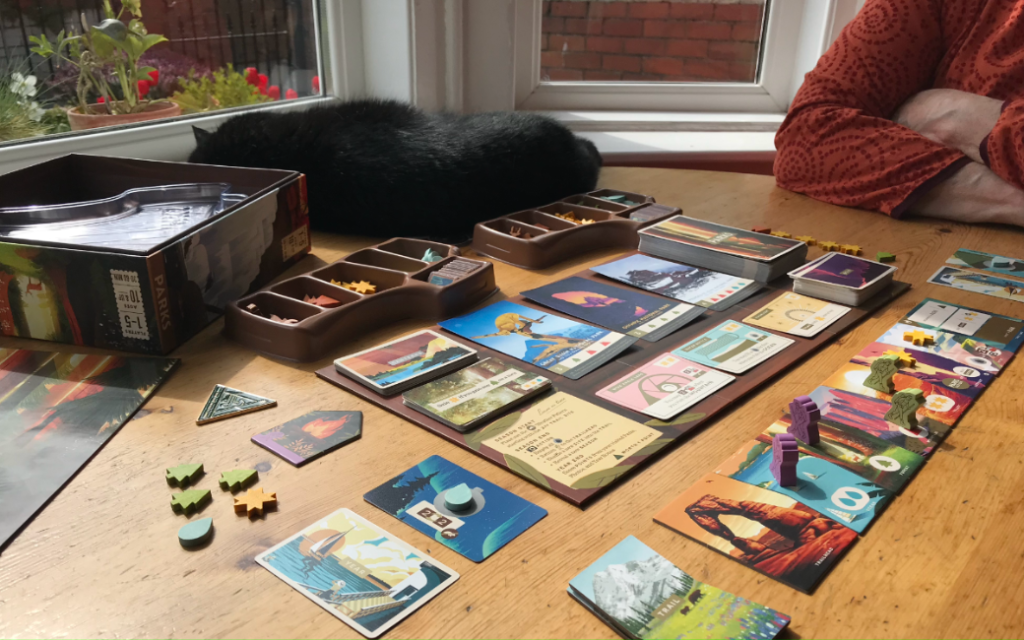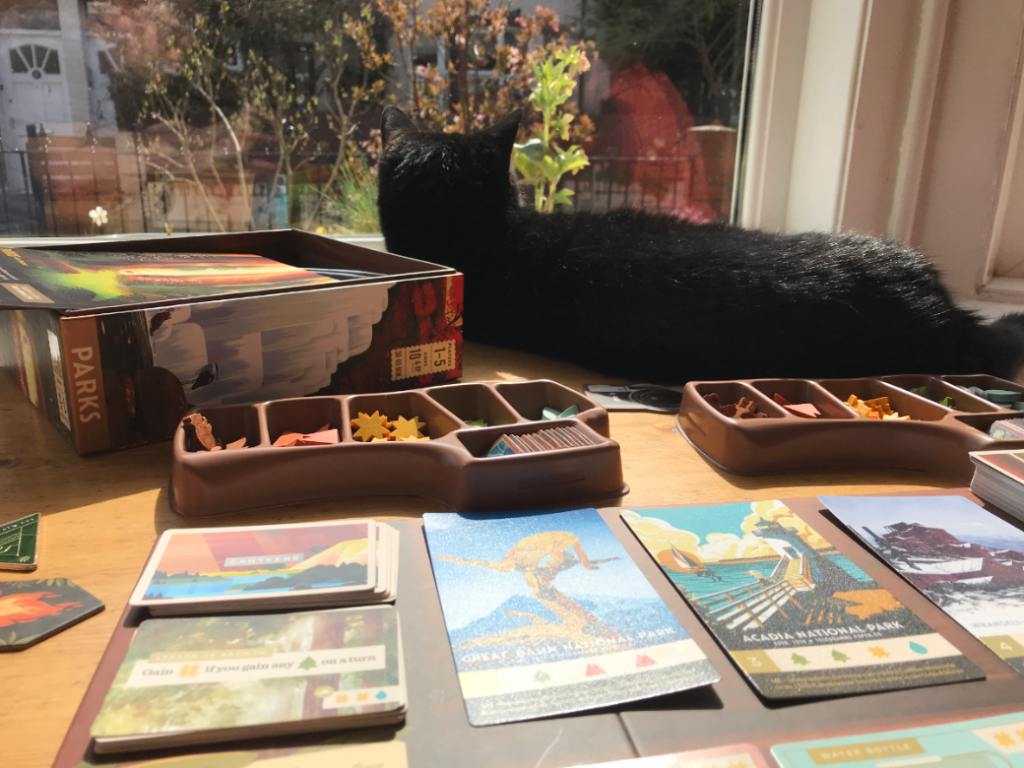Today’s game is not one that should need much introduction with praise from reviewers all over the internet and a solid rating on BGG. It’s PARKS.

The game has several things going for it from the outset. The first is its appearance. It’s a small, well presented game, with lots of colourful art from a wide variety of artists. I mentioned it a few weeks ago as an example of not wasting box space. That’s still true.

As always, I want to pick out a gameplay feature or two to discuss through the lens of a designer. This week it’s something that PARKS does well, and something that is, or should be, an important consideration in any design: layered goals and rewards. What does your game ask the player to do, and what do they get for their efforts? More importantly, how do these different goals interrelate?
Goals and rewards can interact with each other in terms of game resources or VP, extra actions, bonuses, and many other ways, but the most important part of the designed experience is how they layer in time.
For example, imagine we have a game with one goal of coming in first at the end of the race and that’s it. It would be better if there were several end goals, but that’s not as compelling as a game where you have a mini goal for every turn, and a medium one for each of three laps, as well as the final one. These intermediate, smaller goals are there to give texture and layers to the gameplay and keep the interest of the players throughout the duration. Distant goals feel distant emotionally. I might know that my actions are building towards a goal at the end of the game, but if I see no benefit during an hour of play then I may well lose interest before I get there.
PARKS does a very nice job of making you feel like you’ve (a) always got something you’re aiming towards and that thing is pretty close to doable now, and (b) you’re getting rewarded all the time, while always adding to your pile of VP for the end. The overall effect is to make it a game with a lot of positivity that feels like it’s being generous to you. Have some sunshine! Have some more! How about a new canteen? Trees? Mountains? Every move gains you something cool.
PARKS also avoids most of the negative elements which many games include. All of them. You never get punished for going somewhere or doing something; it’s endlessly upbeat. The worst that happens is you have to pay X to get Y, though it’s always a beneficial deal. It is as sunny a world as one in the posters for the parks you visit. Nobody in PARKS will ever get mauled by a grizzly or caught in a forest fire. In fact, you won’t even get ants in your picnic.

In a turn, I’ll usually add to my collection of tokens which I need to buy cards, or I’ll buy a card I’ve got enough for. I’m typically trying to collect X so I can buy Y. Once I’ve bought Y I need to save up to buy Z. Rinse and repeat. All those letters add up to VPs which win the game. As well as this very short-term aim, I’m sometimes buying gear which is a permanent boost (though no VPs), so I’m considering a medium timescale and a balance between utility and VPs. Which will help me most of the three on offer? And then I’ve got my secret year card. These are dealt at the start, you can’t get more, and they give you a small bonus if, at the end, you’ve collected what they ask for. They’re not a major part of the game, but it can give you a bit of an even longer goal to work towards.
Another aspect of the game which helps in this staggered goal approach is its basic structure. In PARKS you will go on four short hikes, moving along the board collecting stuff. It could just as easily have been one long hike, but by resetting and rearranging the board tiles each time, you get a frequently changing puzzle to unpick which avoids it becoming stale and gives you another timescale to play with.
All told, the game balances these different layers of aim very well, and keeps you continually engaged, which is what we, as designers, should be trying to do. Nobody wants to play a game that bores them.
At the moment I’m looking at just this sort of thing in my own current project: Zombie Wars. In many ways it’s a very different beast, and bad things happen all the time in that. However, the core idea of having multiple levels of aim is still present. How does that notion fit into your work?

Sorry for resurrecting your post, but I picked up this game at Gen Con a few months ago. Even crazier, I picked it up because I know my mom loves national Parks and would be thrilled to play it. It wasn’t until later that I was looking the the shape of the token carriers and thinking, “Man! this looks really familiar.” 😀
I will say this, your article MUST have been swimming in my brain because I didn’t stop to play test or examine it at all. I just knew somehow it was a great game and it was a safe buy without testing. 😉